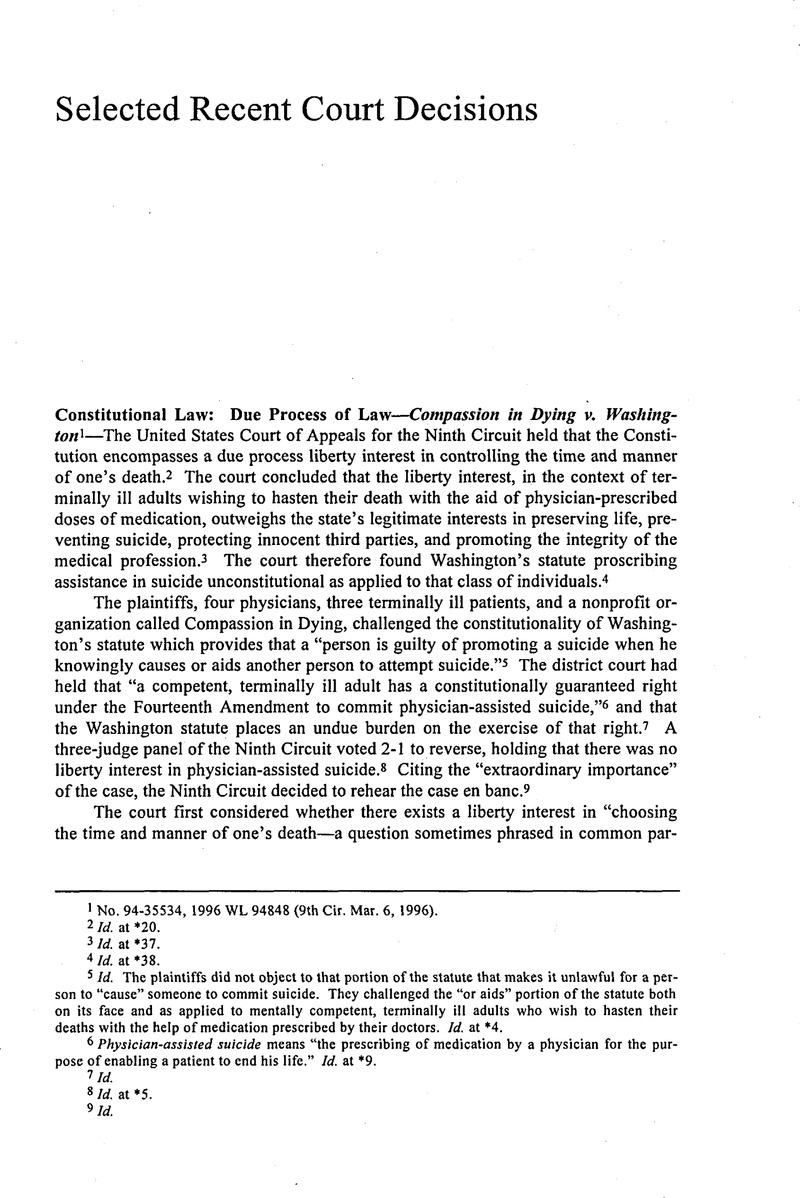No CrossRef data available.
Article contents
Selected Recent Court Decisions
Published online by Cambridge University Press: 24 February 2021
Abstract

- Type
- Medicolegal Reference Library
- Information
- Copyright
- Copyright © American Society of Law, Medicine and Ethics and Boston University 1996
References
1 No. 94-35534, 1996 WL 94848 (9th Cir. Mar. 6, 1996).
2 Id. at *20.
3 Id. at *37.
4 Id. at *38.
5 Id. The plaintiffs did not object to that portion of the statute that makes it unlawful for a per son to “cause" someone to commit suicide. They challenged the “or aids" portion of the statute both on its face and as applied to mentally competent, terminally ill adults who wish to hasten their deaths with the help of medication prescribed by their doctors. Id. at *4.
6 Physician-assisted suicide means “the prescribing of medication by a physician for the purpose of enabling a patient to end his life.” Id. at *9.
7 Id.
8 Id. at *5.
9 Id.
10 Id. The liberty interest is not in “committing suicide,” but in “choosing the time and manner of one’s death" because the interest encompasses a broader range of activities than suicide, including the act of refusing or terminating unwanted medical treatment. Id. at *9.
11 Id. at *7.
12 Id. at *9. The court of appeals did not consider whether the interests involved rose to the level of “fundamental rights.” The U.S. Supreme Court has traditionally utilized two tests to deter mine whether to designate a liberty interest as “fundamental.” The first category includes those liberties that are “implicit in the concept of ordered liberty,” such that “neither liberty nor justice would exist if [they] were sacrificed.” Id. at *10 (quoting Palko v. Connecticut, 302 U.S. 319, 325- 26 (1937)). According to the second traditional characterization, rights are “fundamental" when “deeply rooted in this Nation’s history and tradition.” Id. (quoting Moore v. East Cleveland, 431 U.S. 494, 503(1977)).
13 Id. at *16. The court noted generally that “while historical analysis plays a useful role in any attempt to determine whether a claimed right or liberty interest exists, earlier legislative or judicial recognition of the right or interest is not a sine qua non.” Id. at *11.
14 Id. at *16.
15 505 U.S. 833(1992).
16 497 U.S. 261 (1990).
17 Compassion in Dying, 1996 WL 94848, at *18.
18 Id. at *19 (quoting Casey, 505 U.S. at 851).
19 Id.
20 Cruzan, 497 U.S. at 278.
21 Compassion in Dying, 1996 WL 94848, at *20.
22 Id.
23 Id. at *21.
24 Id. at *11.
25 Id. The court stated that the strength of the liberty interest fluctuates depending on certain factors, especially the individual’s physical condition. “When a mentally competent adult is terminally ill and wishes, free of any coercion, to hasten his death because his remaining days are an unmitigated torture, that person’s liberty interest is at its height.” Id. at *35.
26 Id. at *38.
27 Id. at *21.
28 Id. at *22.
28 Id.
29 Id.
30 >Id. at *23.
31 Id.
32 Id. The court noted that the state’s interest in preventing suicide may not even be implicated in this case. Notwithstanding the use of the term physician-assisted suicide, the court found no significant difference between the prescription of a lethal dose of medication and a patient’s decision to terminate life support or to refuse food and hydration (actions which the state does not deem suicide). Id. at *26.
33 Id. at *28.
34 Id.
35 Id.
36 Id.
37 Id.
38 Id. at *29.
39 Id.
40 Id. at *30. A doctor’s prescription of medication primarily to relieve a patient’s pain and suffering is a proper medical function even if the doctor knows the patient will die because of that action. Id.
41 Id. at *33.
42 Id.
43 Id. at *34. The court noted some potential procedural safeguards, “without endorsing [their] constitutionality.” Id. Examples include: witnesses to ensure voluntariness, short waiting periods to prevent impulsive decisions, and psychological evaluations to guarantee that the patient does not suffer from treatable depression. Id.
44 Id. at *35.
45 Id. at *37-38.
46 Id. at *39.
47 See Lee v. Oregon, 891 F. Supp. 1429 (D. Or. 1995). Although the expected appeal of Lee was not at issue here, the court described the holding reached in that case as “highly irregular,” and noted that Chief Judge Hogan, author of the Lee opinion, had “clearly erred.” Compassion in Dying, 1996 WL 94848, at *38.
48 The Second Circuit recently reviewed a similar statute. Using a different approach, the Second Circuit held that laws “criminalizing assisted suicide violate the Equal Protection Clause, because to the extent that they prohibit a physician from proscribing medications to be self- administered by a mentally competent, terminally-ill person in the final stages of his terminal illness, they are not rationally related to any legitimate state interest.” Quill v. Vacco, No. 95-7028, 1996 U.S. App. LEXIS 6215, at *47 (2d Cir. Apr. 2, 1996).


